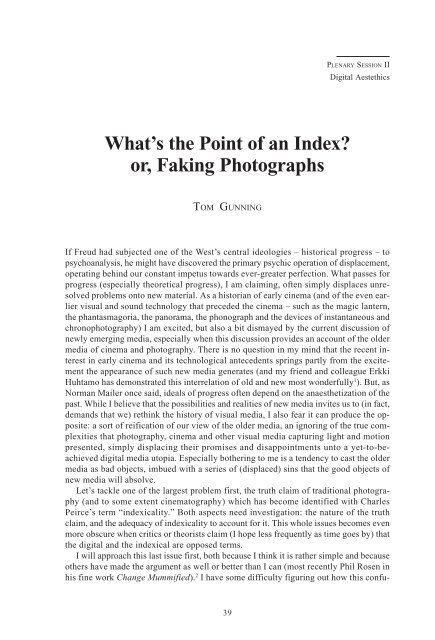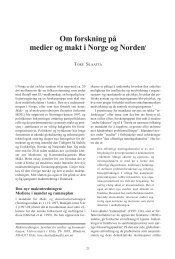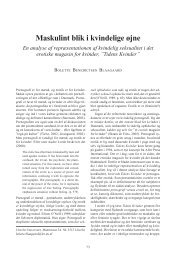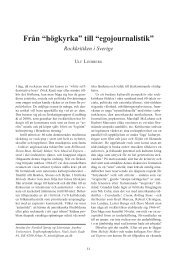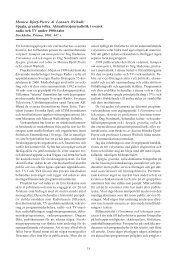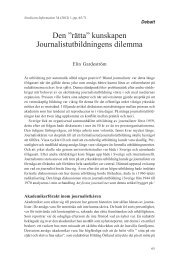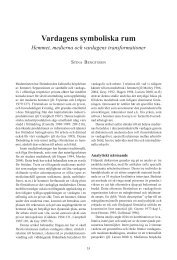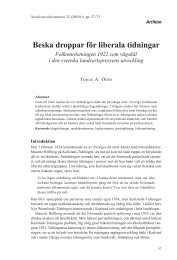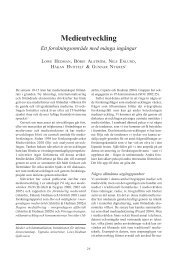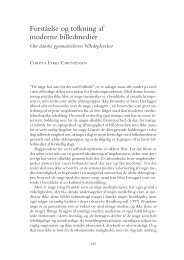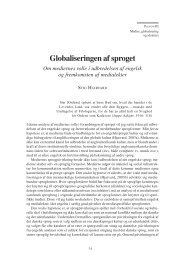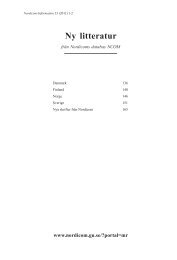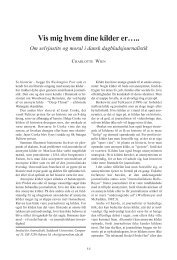What's the Point of an Index? or, Faking Photographs - Nordicom
What's the Point of an Index? or, Faking Photographs - Nordicom
What's the Point of an Index? or, Faking Photographs - Nordicom
Create successful ePaper yourself
Turn your PDF publications into a flip-book with our unique Google optimized e-Paper software.
WHAT’S THE POINT OF AN INDEX? OR, FAKING PHOTOGRAPHS<br />
What’s <strong>the</strong> <strong>Point</strong> <strong>of</strong> <strong>an</strong> <strong>Index</strong>?<br />
<strong>or</strong>, <strong>Faking</strong> <strong>Photographs</strong><br />
TOM GUNNING<br />
39<br />
PLENARY SESSION II<br />
Digital Aestethics<br />
If Freud had subjected one <strong>of</strong> <strong>the</strong> West’s central ideologies – hist<strong>or</strong>ical progress – to<br />
psycho<strong>an</strong>alysis, he might have discovered <strong>the</strong> primary psychic operation <strong>of</strong> displacement,<br />
operating behind our const<strong>an</strong>t impetus towards ever-greater perfection. What passes f<strong>or</strong><br />
progress (especially <strong>the</strong><strong>or</strong>etical progress), I am claiming, <strong>of</strong>ten simply displaces unresolved<br />
problems onto new material. As a hist<strong>or</strong>i<strong>an</strong> <strong>of</strong> early cinema (<strong>an</strong>d <strong>of</strong> <strong>the</strong> even earlier<br />
visual <strong>an</strong>d sound technology that preceded <strong>the</strong> cinema – such as <strong>the</strong> magic l<strong>an</strong>tern,<br />
<strong>the</strong> ph<strong>an</strong>tasmag<strong>or</strong>ia, <strong>the</strong> p<strong>an</strong><strong>or</strong>ama, <strong>the</strong> phonograph <strong>an</strong>d <strong>the</strong> devices <strong>of</strong> inst<strong>an</strong>t<strong>an</strong>eous <strong>an</strong>d<br />
chronophotography) I am excited, but also a bit dismayed by <strong>the</strong> current discussion <strong>of</strong><br />
newly emerging media, especially when this discussion provides <strong>an</strong> account <strong>of</strong> <strong>the</strong> older<br />
media <strong>of</strong> cinema <strong>an</strong>d photography. There is no question in my mind that <strong>the</strong> recent interest<br />
in early cinema <strong>an</strong>d its technological <strong>an</strong>tecedents springs partly from <strong>the</strong> excitement<br />
<strong>the</strong> appear<strong>an</strong>ce <strong>of</strong> such new media generates (<strong>an</strong>d my friend <strong>an</strong>d colleague Erkki<br />
Huhtamo has demonstrated this interrelation <strong>of</strong> old <strong>an</strong>d new most wonderfully 1 ). But, as<br />
N<strong>or</strong>m<strong>an</strong> Mailer once said, ideals <strong>of</strong> progress <strong>of</strong>ten depend on <strong>the</strong> <strong>an</strong>aes<strong>the</strong>tization <strong>of</strong> <strong>the</strong><br />
past. While I believe that <strong>the</strong> possibilities <strong>an</strong>d realities <strong>of</strong> new media invites us to (in fact,<br />
dem<strong>an</strong>ds that we) rethink <strong>the</strong> hist<strong>or</strong>y <strong>of</strong> visual media, I also fear it c<strong>an</strong> produce <strong>the</strong> opposite:<br />
a s<strong>or</strong>t <strong>of</strong> reification <strong>of</strong> our view <strong>of</strong> <strong>the</strong> older media, <strong>an</strong> ign<strong>or</strong>ing <strong>of</strong> <strong>the</strong> true complexities<br />
that photography, cinema <strong>an</strong>d o<strong>the</strong>r visual media capturing light <strong>an</strong>d motion<br />
presented, simply displacing <strong>the</strong>ir promises <strong>an</strong>d disappointments unto a yet-to-beachieved<br />
digital media utopia. Especially bo<strong>the</strong>ring to me is a tendency to cast <strong>the</strong> older<br />
media as bad objects, imbued with a series <strong>of</strong> (displaced) sins that <strong>the</strong> good objects <strong>of</strong><br />
new media will absolve.<br />
Let’s tackle one <strong>of</strong> <strong>the</strong> largest problem first, <strong>the</strong> truth claim <strong>of</strong> traditional photography<br />
(<strong>an</strong>d to some extent cinematography) which has become identified with Charles<br />
Peirce’s term “indexicality.” Both aspects need investigation: <strong>the</strong> nature <strong>of</strong> <strong>the</strong> truth<br />
claim, <strong>an</strong>d <strong>the</strong> adequacy <strong>of</strong> indexicality to account f<strong>or</strong> it. This whole issues becomes even<br />
m<strong>or</strong>e obscure when critics <strong>or</strong> <strong>the</strong><strong>or</strong>ists claim (I hope less frequently as time goes by) that<br />
<strong>the</strong> digital <strong>an</strong>d <strong>the</strong> indexical are opposed terms.<br />
I will approach this last issue first, both because I think it is ra<strong>the</strong>r simple <strong>an</strong>d because<br />
o<strong>the</strong>rs have made <strong>the</strong> argument as well <strong>or</strong> better th<strong>an</strong> I c<strong>an</strong> (most recently Phil Rosen in<br />
his fine w<strong>or</strong>k Ch<strong>an</strong>ge Mummified). 2 I have some difficulty figuring out how this confu-
TOM GUNNING<br />
sion arose, but I imagine it went something like this: <strong>the</strong> indexicality <strong>of</strong> <strong>the</strong> photograph<br />
depends on a physical relation between <strong>the</strong> object photographed <strong>an</strong>d <strong>the</strong> image finally<br />
created. The image on <strong>the</strong> photographic negative derives from <strong>the</strong> tr<strong>an</strong>sf<strong>or</strong>mation <strong>of</strong> light<br />
sensitive emulsion caused by light reflecting <strong>of</strong>f <strong>the</strong> object photographed filtered through<br />
<strong>the</strong> lens <strong>an</strong>d diaphragm. In a digital image, however, instead <strong>of</strong> light sensitive emulsion<br />
affected by <strong>the</strong> luminous object, <strong>the</strong> image is f<strong>or</strong>med through data about light that is<br />
encoded in a matrix <strong>of</strong> numbers.<br />
But what problem does this ch<strong>an</strong>ge present <strong>an</strong>d how does it challenge indexicality?<br />
Clearly a digital camera rec<strong>or</strong>ds through its numerical data <strong>the</strong> same intensities <strong>of</strong> light<br />
that a non-digital camera rec<strong>or</strong>ds: hence <strong>the</strong> similarity <strong>of</strong> <strong>the</strong>ir images. The difference<br />
between <strong>the</strong> digital <strong>an</strong>d <strong>the</strong> film based camera has to do with <strong>the</strong> way <strong>the</strong> inf<strong>or</strong>mation is<br />
captured – which does have strong implications f<strong>or</strong> <strong>the</strong> way <strong>the</strong> images c<strong>an</strong> be st<strong>or</strong>ed,<br />
tr<strong>an</strong>sferred <strong>an</strong>d indeed m<strong>an</strong>ipulated. But st<strong>or</strong>age in terms <strong>of</strong> numerical data does not<br />
eliminate indexicality (which is why digital images c<strong>an</strong> serves as passp<strong>or</strong>t photographs<br />
<strong>an</strong>d <strong>the</strong> o<strong>the</strong>r s<strong>or</strong>ts <strong>of</strong> legal evidence <strong>or</strong> documents, which <strong>or</strong>dinary photographs supply).<br />
Fur<strong>the</strong>r, it would be foolish to closely identify <strong>the</strong> indexical with <strong>the</strong> photographic; most<br />
indexical inf<strong>or</strong>mation is not rec<strong>or</strong>ded by photography. Long bef<strong>or</strong>e digital media were<br />
introduced, medical instruments <strong>an</strong>d o<strong>the</strong>r instrument <strong>of</strong> measurement, indexical instruments<br />
par excell<strong>an</strong>ce – such as devices f<strong>or</strong> reading pulse rate, temperature, heart rate,<br />
etc, <strong>or</strong> speedometers, wind gauges, <strong>an</strong>d barometers – all converted <strong>the</strong>ir inf<strong>or</strong>mation into<br />
numbers.<br />
Although a photograph combines both types <strong>of</strong> signs, <strong>the</strong> indexical quality <strong>of</strong> a photograph<br />
must not be confused with its iconicity. The fact that rows <strong>of</strong> numbers do not<br />
resemble a photograph, <strong>or</strong> what <strong>the</strong> photograph is supposed to represent, does not undermine<br />
<strong>an</strong>y indexical claim. An index need not (<strong>an</strong>d frequently does not) resemble <strong>the</strong> thing<br />
it represents. The indexicality <strong>of</strong> a traditional photograph inheres in <strong>the</strong> effect <strong>of</strong> light on<br />
chemicals, not in <strong>the</strong> picture it produces. The rows <strong>of</strong> numerical data produced by a digital<br />
camera <strong>an</strong>d <strong>the</strong> image <strong>of</strong> traditional chemical photography are both indexically determined<br />
by objects outside <strong>the</strong> camera. Both photographic chemicals <strong>an</strong>d <strong>the</strong> digital data<br />
must be subjected to elab<strong>or</strong>ate procedures bef<strong>or</strong>e a picture will result. Here we might<br />
grasp how <strong>the</strong> claim f<strong>or</strong> digital uniqueness displaces a problematic issue within our conception<br />
<strong>of</strong> traditional photography, <strong>an</strong> especially pernicious one. The claim that <strong>the</strong> digital<br />
media alone tr<strong>an</strong>sf<strong>or</strong>ms its data into <strong>an</strong> intermediary f<strong>or</strong>m fosters <strong>the</strong> myth that photography<br />
involves a tr<strong>an</strong>sparent process, a direct tr<strong>an</strong>sfer from <strong>the</strong> object to <strong>the</strong> photograph.<br />
The mediation <strong>of</strong> lens, film stock, exposure rate, type <strong>of</strong> shutter, processes <strong>of</strong><br />
developing <strong>an</strong>d <strong>of</strong> printing become magically whisked away if one considers <strong>the</strong> photograph<br />
as a direct imprint <strong>of</strong> reality.<br />
Thus <strong>the</strong> very strong claim that digital images c<strong>an</strong> be m<strong>an</strong>ipulated in ways photographic<br />
images could not, must also be qualified. Indeed <strong>the</strong> much-heralded malleability<br />
<strong>of</strong> <strong>the</strong> digital image does not contrast absolutely with photography. I would not deny<br />
that <strong>the</strong> ease, speed <strong>an</strong>d quality <strong>of</strong> digital m<strong>an</strong>ipulation represent <strong>an</strong> imp<strong>or</strong>t<strong>an</strong>t new stage<br />
in <strong>the</strong> technology <strong>of</strong> imagery. But we must carefully consider <strong>the</strong> situations in which such<br />
malleability becomes a value <strong>an</strong>d <strong>the</strong> considerable debt such tr<strong>an</strong>sf<strong>or</strong>mations owe to<br />
(although <strong>of</strong>ten displacing our attention from) <strong>the</strong> hist<strong>or</strong>y <strong>of</strong> photography. Here especially,<br />
<strong>the</strong> intertwining <strong>of</strong> indexicality <strong>an</strong>d iconicity must be observed.<br />
Let us gr<strong>an</strong>t f<strong>or</strong> <strong>the</strong> moment, <strong>the</strong> ability <strong>of</strong> digital photography to absolutely tr<strong>an</strong>sf<strong>or</strong>m<br />
<strong>the</strong> appear<strong>an</strong>ce <strong>of</strong> <strong>the</strong> object <strong>or</strong>iginally photographed. If we gr<strong>an</strong>t that <strong>the</strong> <strong>or</strong>iginal digital<br />
photograph <strong>of</strong> Uncle Harry was indexical (<strong>an</strong>d <strong>the</strong>ref<strong>or</strong>e bears <strong>an</strong> imp<strong>or</strong>t<strong>an</strong>t relation<br />
40
WHAT’S THE POINT OF AN INDEX? OR, FAKING PHOTOGRAPHS<br />
to <strong>the</strong> actual Uncle Harry), what happens when we <strong>the</strong>n intervene on <strong>the</strong> data in a Photoshop<br />
program <strong>an</strong>d tr<strong>an</strong>sf<strong>or</strong>m his nose into a pronounced beak, his baldhead into a shaggy<br />
wilderness, turn his brown eyes blue? Surely <strong>the</strong> indexical is being attenuated! Two <strong>an</strong>swers<br />
are relev<strong>an</strong>t here, both <strong>of</strong> which depend on a qualified yes. Yes, but … film-based<br />
photography c<strong>an</strong> also tr<strong>an</strong>sf<strong>or</strong>m Uncle Harry’s appear<strong>an</strong>ce, whe<strong>the</strong>r through retouching,<br />
use <strong>of</strong> filters <strong>or</strong> lenses, selection <strong>of</strong> <strong>an</strong>gle <strong>of</strong> photography, exposure time, use <strong>of</strong> specially<br />
prepared chemicals in <strong>the</strong> developing stage, <strong>or</strong> adding elements through multiple printing.<br />
Traditional photography, <strong>the</strong>ref<strong>or</strong>e, also possesses processes that c<strong>an</strong> attenuate, ign<strong>or</strong>e,<br />
<strong>or</strong> even undo <strong>the</strong> indexical. No question digital processes c<strong>an</strong> perf<strong>or</strong>m <strong>the</strong>se alterations<br />
m<strong>or</strong>e quickly <strong>an</strong>d m<strong>or</strong>e seamlessly, but <strong>the</strong> difference between digital <strong>an</strong>d filmbased<br />
photography c<strong>an</strong>not be described as absolute.<br />
But a m<strong>or</strong>e complex <strong>an</strong>d, I think, m<strong>or</strong>e interesting <strong>an</strong>swer would point out that <strong>the</strong><br />
power <strong>of</strong> <strong>the</strong> digital (<strong>or</strong> even <strong>the</strong> traditional photographic) to “tr<strong>an</strong>sf<strong>or</strong>m” <strong>an</strong> image depends<br />
on maintaining something <strong>of</strong> <strong>the</strong> <strong>or</strong>iginal image’s visual accuracy <strong>an</strong>d recognizability.<br />
I use this phrase (“visual accuracy <strong>an</strong>d recognizability”) to indicate <strong>the</strong> m<strong>an</strong>ner<br />
in which indexicality intertwines with iconicity in our common assessment <strong>of</strong> photographs.<br />
Our evaluation <strong>of</strong> a photograph as accurate (i.e. visually reflecting its subject)<br />
depends not simply on its indexical basis (<strong>the</strong> chemical process), but on our recognition<br />
<strong>of</strong> it as looking like its subject. A host <strong>of</strong> psychological <strong>an</strong>d perceptual processes intervene<br />
here which c<strong>an</strong>not be reduced to <strong>the</strong> indexical process. The recognition <strong>of</strong> a photograph<br />
by a viewer as <strong>an</strong> image <strong>of</strong> its subject would not simply result from indexically.<br />
Indeed, one could produce <strong>an</strong> indexical image <strong>of</strong> something <strong>or</strong> someone that remained<br />
unrecognizable. The image must also be legible in <strong>or</strong>der to be likened to its subject.<br />
Let me get at this via <strong>an</strong>o<strong>the</strong>r route. If one <strong>of</strong> <strong>the</strong> great consequences <strong>of</strong> <strong>the</strong> digital<br />
revolution lies in <strong>the</strong> freedom it gives people to tr<strong>an</strong>sf<strong>or</strong>m a photographic image, we<br />
could say that <strong>the</strong> digital aspires to <strong>the</strong> condition <strong>of</strong> painting, in which col<strong>or</strong>, shape, texture,<br />
all <strong>the</strong> components <strong>of</strong> <strong>an</strong> image are completely up to <strong>the</strong> painter, ra<strong>the</strong>r th<strong>an</strong> determined<br />
by <strong>the</strong> <strong>or</strong>iginal subject through <strong>an</strong> indexical process. But do users <strong>of</strong> Photoshop<br />
w<strong>an</strong>t <strong>an</strong> absolute freedom? Do <strong>the</strong>y really w<strong>an</strong>t to create <strong>an</strong> image <strong>or</strong>, ra<strong>the</strong>r, to tr<strong>an</strong>sf<strong>or</strong>m<br />
one which c<strong>an</strong> still be recognized as a photograph (<strong>an</strong>d maybe even as a photograph<br />
<strong>of</strong> Uncle Harry?)<br />
The interest in tr<strong>an</strong>sf<strong>or</strong>ming Uncle Harry’s photograph is not quite <strong>the</strong> same as that<br />
<strong>of</strong> drawing a caricature <strong>of</strong> him. Admittedly one could point out that few <strong>of</strong> us have <strong>the</strong><br />
depictive talent to produce a caricature, <strong>an</strong>d that digital m<strong>an</strong>ipulation programs give us<br />
that power (interestingly this recalls <strong>the</strong> argument Fox Talbot gave f<strong>or</strong> his invention <strong>of</strong><br />
photography). But it seems to me that <strong>the</strong> power <strong>of</strong> most digital m<strong>an</strong>ipulation <strong>of</strong> photographs<br />
depends on our recognizing <strong>the</strong>m as m<strong>an</strong>ipulated photographs, being aware <strong>of</strong><br />
<strong>the</strong> strata <strong>of</strong> <strong>the</strong> indexical (<strong>or</strong> perhaps better, <strong>the</strong> visually recognizable) beneath <strong>the</strong> m<strong>an</strong>ipulation.<br />
The wonderful playfulness celebrated in <strong>the</strong> digital revolution remains parasitic on <strong>the</strong><br />
initial claim <strong>of</strong> accuracy contained in some uses <strong>of</strong> photography. Just as I tried to unt<strong>an</strong>gle<br />
<strong>the</strong> idea <strong>of</strong> visual accuracy from simple indexicality, I would now like to consider <strong>the</strong><br />
“truth claim” <strong>of</strong> photography that relies on both indexicality <strong>an</strong>d visual accuracy but<br />
includes m<strong>or</strong>e (<strong>an</strong>d perhaps less) th<strong>an</strong> ei<strong>the</strong>r <strong>of</strong> <strong>the</strong>m. A great deal <strong>of</strong> <strong>the</strong> discussion <strong>of</strong><br />
<strong>the</strong> digital revolution has involved its effect <strong>of</strong> <strong>the</strong> truth claim <strong>of</strong> photography, ei<strong>the</strong>r from<br />
a par<strong>an</strong>oid position (photographs will be m<strong>an</strong>ipulated to serve as evidence <strong>of</strong> things<br />
which do not exist <strong>the</strong>reby m<strong>an</strong>ipulating <strong>the</strong> population to believe in things that do not<br />
exist), <strong>or</strong> from what we might call a schizophrenic position (celebrating <strong>the</strong> release <strong>of</strong><br />
41
TOM GUNNING<br />
photographic images from claims <strong>of</strong> truth, issuing in a w<strong>or</strong>ld presumably <strong>of</strong> universal<br />
doubt <strong>an</strong>d play, allowing us to cav<strong>or</strong>t endlessly in <strong>the</strong> veils <strong>of</strong> Maya).<br />
I use <strong>the</strong> w<strong>or</strong>d “truth claim” because I w<strong>an</strong>t to emphasize that this is not simply a<br />
property inherent in a photograph, but a claim made f<strong>or</strong> it (dependent, <strong>of</strong> course, on our<br />
underst<strong>an</strong>ding <strong>of</strong> its inherent properties). Perhaps its Ur-f<strong>or</strong>m c<strong>an</strong> be found in Dion<br />
Boucicualt’s 1859 melodrama The Oct<strong>or</strong>oon, in which Scudder, <strong>the</strong> play’s Y<strong>an</strong>kee “photographic<br />
operat<strong>or</strong>”, discovers that <strong>an</strong> act <strong>of</strong> murder has been rec<strong>or</strong>ded by a camera. He<br />
<strong>of</strong>fers <strong>the</strong> photograph as evidence to a lynch mob about to string up <strong>an</strong> Indi<strong>an</strong> falsely<br />
accused <strong>of</strong> <strong>the</strong> murder, declaring, “’Tis true! <strong>the</strong> apparatus c<strong>an</strong>’t lie!” 3<br />
We might add immediately that <strong>the</strong> apparatus, in itself, c<strong>an</strong> nei<strong>the</strong>r lie, n<strong>or</strong> tell <strong>the</strong> truth.<br />
Bereft <strong>of</strong> l<strong>an</strong>guage, a photograph relies on people to say things about it <strong>or</strong> f<strong>or</strong> it. It is no<br />
accident that Boucicault’s melodrama involves a mock trial in which <strong>the</strong> photograph exonerates<br />
<strong>the</strong> falsely accused Indi<strong>an</strong> chief Wahnotee <strong>an</strong>d determines <strong>the</strong> true culprit. Given<br />
<strong>the</strong> early date <strong>of</strong> this play characters question whe<strong>the</strong>r a court <strong>of</strong> law would actually accept<br />
such evidence. Both hist<strong>or</strong>ically <strong>an</strong>d institutionally, in <strong>or</strong>der to tell <strong>the</strong> truth, <strong>the</strong> photograph<br />
must be subjected to a series <strong>of</strong> discourses, become, in effect, <strong>the</strong> supp<strong>or</strong>ting evidence f<strong>or</strong><br />
a statement. Anyone who knows ei<strong>the</strong>r <strong>the</strong> complex hist<strong>or</strong>y by which photographs were<br />
gr<strong>an</strong>ted evidentiary status in legal trial, <strong>or</strong> indeed <strong>the</strong> scrutiny <strong>an</strong>d discussion to which <strong>the</strong>y<br />
must be subjected bef<strong>or</strong>e <strong>the</strong>y are gr<strong>an</strong>ted such status in contemp<strong>or</strong>ary trials must realize<br />
that in <strong>or</strong>der to speak <strong>the</strong> truth <strong>the</strong> photograph must be integrated into a statement, subjected<br />
to complex rules <strong>of</strong> discourse – legal, rhet<strong>or</strong>ical <strong>an</strong>d even scientific (discussing all <strong>the</strong> aspect<br />
<strong>of</strong> <strong>the</strong> photograph, its exposure, developing <strong>an</strong>d printing).<br />
But I think we would also have to contradict Scudder <strong>an</strong>d say a photograph c<strong>an</strong> only<br />
tell <strong>the</strong> truth if it is also capable <strong>of</strong> telling a lie. In o<strong>the</strong>r w<strong>or</strong>ds, <strong>the</strong> truth claim is always<br />
a claim <strong>an</strong>d lurking behind it is a suspicion <strong>of</strong> fakery, even if <strong>the</strong> default mode is belief.<br />
In o<strong>the</strong>r w<strong>or</strong>ds, <strong>the</strong> value placed on <strong>the</strong> visual accuracy <strong>of</strong> a photograph, founded on its<br />
combination <strong>of</strong> indexicality <strong>an</strong>d iconicity, f<strong>or</strong>ms <strong>the</strong> basis <strong>of</strong> a truth claim that c<strong>an</strong> be<br />
made in a variety <strong>of</strong> discourses whe<strong>the</strong>r legal (“Here we see <strong>the</strong> accused caught by a surveill<strong>an</strong>ce<br />
camera…”) <strong>or</strong> less f<strong>or</strong>mal <strong>an</strong>d interpersonal (“Yes, his penis really is that<br />
big…”). But in so far as this value <strong>of</strong> visual accuracy exists, <strong>the</strong>re will always be a drive<br />
to counterfeit it. The truth implies <strong>the</strong> possibility <strong>of</strong> lying, <strong>an</strong>d vice versa.<br />
<strong>Faking</strong> photograph has a long hist<strong>or</strong>y <strong>an</strong>d was always possible given <strong>the</strong> processes that<br />
intervene <strong>or</strong> shape <strong>the</strong> indexical process as it becomes a picture. Spirit photography, <strong>the</strong><br />
attempt by Spiritualist to prove <strong>the</strong> survival <strong>of</strong> a soul after death by capturing its image,<br />
a practice dear to my heart, provides only one early example. 4 The variety <strong>of</strong> doct<strong>or</strong>ed<br />
photographs f<strong>or</strong> political purposes is <strong>an</strong>o<strong>the</strong>r. 5 But my point here is not simply to claim<br />
ei<strong>the</strong>r that <strong>the</strong> m<strong>an</strong>ipulatability <strong>of</strong> photographs predates <strong>the</strong> digital (undeniable) <strong>or</strong> that<br />
this practice was frequently employed in circumst<strong>an</strong>ces where truth claims were attempted<br />
(undoubted). Ra<strong>the</strong>r my point is that <strong>the</strong> practice <strong>of</strong> faking <strong>or</strong> counterfeiting c<strong>an</strong><br />
only exist when true coin <strong>of</strong> <strong>the</strong> realm exists as well. Ra<strong>the</strong>r th<strong>an</strong> denying photography’s<br />
truth claim, <strong>the</strong> practice <strong>of</strong> faking photographs depends upon <strong>an</strong>d demonstrates it.<br />
Thus <strong>the</strong> concern over, <strong>or</strong> <strong>the</strong> celebration <strong>of</strong>, <strong>the</strong> possibility <strong>of</strong> <strong>the</strong> digital undermining<br />
<strong>the</strong> association <strong>of</strong> photography with a truth claim involves <strong>an</strong> inherent contradiction.<br />
If <strong>the</strong> digital undermines <strong>the</strong> truth claim <strong>of</strong> photography, we will have to ask in what<br />
contexts this occurs. Within interpersonal relations someone could digitally alter <strong>the</strong> size<br />
<strong>of</strong> his penis in a photograph <strong>an</strong>d most likely a general incredulity about extra<strong>or</strong>dinary<br />
photographs has already set in within <strong>the</strong> personal exch<strong>an</strong>ge <strong>of</strong> images. But in cases <strong>of</strong><br />
legal <strong>or</strong> scientific evidence protocols are set in place f<strong>or</strong> determining <strong>the</strong> process by<br />
42
WHAT’S THE POINT OF AN INDEX? OR, FAKING PHOTOGRAPHS<br />
which <strong>the</strong> photograph would be made <strong>an</strong>d <strong>the</strong> likelihood <strong>of</strong> its accuracy. Clearly journalism<br />
(<strong>an</strong>d governmental use <strong>of</strong> <strong>the</strong> media) pose arenas in which <strong>the</strong> greatest concern<br />
abounds. But equally clearly, institutions <strong>of</strong> journalism <strong>an</strong>d government watchdog <strong>or</strong>g<strong>an</strong>izations<br />
will endeav<strong>or</strong> to preserve <strong>the</strong> possibility (<strong>the</strong> inevitability is not <strong>an</strong> issue) <strong>of</strong><br />
photographs supp<strong>or</strong>ting truth claims in certain situations. I by no me<strong>an</strong>s claim that conspiracies<br />
<strong>of</strong> deception c<strong>an</strong>not exist, but simply that <strong>the</strong>y will not differ essentially from<br />
o<strong>the</strong>r attempts at political deception. Ge<strong>or</strong>ge Bush did not provide photographs <strong>of</strong> Iraq’s<br />
“weapons <strong>of</strong> mass destruction” to justify his invasion (although Colin Powell did attempt<br />
some ra<strong>the</strong>r vague photographic evidence in his address to <strong>the</strong> United Nations<br />
Thus a recent journalism text book dedicated to this issue proposes that <strong>or</strong>g<strong>an</strong>izations<br />
dedicated to rep<strong>or</strong>ting news take a pledge <strong>of</strong> “Truth <strong>an</strong>d Accuracy in Media Photography”<br />
<strong>an</strong>d that <strong>or</strong>g<strong>an</strong>izations so pledging could display “a badge <strong>or</strong> symbol certifying <strong>the</strong>ir<br />
commitment” to <strong>the</strong> visual integrity <strong>of</strong> <strong>the</strong>ir images (i.e. that <strong>the</strong>y have not been altered<br />
digitally). 6 My point is not to predict if such a practice will be widely adopted, but ra<strong>the</strong>r<br />
to demonstrate that truth claims about photographs possess <strong>an</strong> institutional value in specific<br />
circumst<strong>an</strong>ces (<strong>the</strong> text book I quoted at one point queries it journalism student<br />
readers: “Will we Photoshop ourselves out <strong>of</strong> a job?”). 7 Theref<strong>or</strong>e me<strong>an</strong>s will be taken<br />
to preserve this value, even in <strong>an</strong> era where it is easy <strong>an</strong>d cheap to alter photographs <strong>an</strong>d<br />
produce a believable image. The truth claim must always be supp<strong>or</strong>ted by rules <strong>of</strong> discourse,<br />
whe<strong>the</strong>r rig<strong>or</strong>ously defined (as in scientific <strong>or</strong> legal evidence) <strong>or</strong> inherent in general<br />
practice (as in <strong>the</strong> belief that news rep<strong>or</strong>ting generally tells <strong>the</strong> truth; It seems to me<br />
that doubts about journalists’ commitments to <strong>the</strong> truth m<strong>or</strong>e likely undermine belief in<br />
<strong>the</strong> truth claim <strong>of</strong> a photograph th<strong>an</strong> <strong>the</strong> simple fact <strong>of</strong> technical m<strong>an</strong>ipulability).<br />
Likewise <strong>the</strong> use <strong>of</strong> photographs as evidence, whe<strong>the</strong>r legal <strong>or</strong> scientific, has always<br />
entailed a considerable disciplining <strong>of</strong> <strong>the</strong> photographic image. Consistency <strong>an</strong>d unif<strong>or</strong>mity<br />
<strong>of</strong> photographic processes (such as <strong>the</strong> very specific m<strong>an</strong>uals written f<strong>or</strong> police photographers<br />
<strong>or</strong> <strong>the</strong> strictly determined routine <strong>of</strong> dist<strong>an</strong>ce, camera <strong>an</strong>gle, lighting, <strong>an</strong>d type<br />
<strong>of</strong> lens <strong>an</strong>d apparatus used in <strong>the</strong> creation <strong>of</strong> Bertilon’s photographs <strong>of</strong> criminal f<strong>or</strong> use<br />
in identification) 8 rule institution photographic practices. A photograph’s use as evidence<br />
<strong>or</strong> scientific data <strong>of</strong>ten has to contend with <strong>the</strong> excesses <strong>of</strong> its intertwined indexical <strong>an</strong>d<br />
iconic aspects. F<strong>or</strong> scientists photographs frequently rec<strong>or</strong>ded too much inf<strong>or</strong>mation, <strong>an</strong>d,<br />
as Peter Galison has shown, scientists debated whe<strong>the</strong>r to remove this excessive inf<strong>or</strong>mation<br />
<strong>or</strong> to f<strong>or</strong>thrightly acknowledge it. 9<br />
Etienne Jules Marey (whose chronophotography provides <strong>the</strong> most direct <strong>an</strong>cest<strong>or</strong> <strong>of</strong><br />
<strong>the</strong> commercial cinema) provides a fascinating example as Joel Snyder <strong>an</strong>d Marta Braun<br />
have shown. 10 Marey’s first investigations <strong>of</strong> <strong>the</strong> hum<strong>an</strong> <strong>an</strong>d <strong>an</strong>imal body in motion used<br />
instruments that provided only numerical readings <strong>or</strong> graphic inscriptions. However, after<br />
encountering Eadweard Muybridge’s serial photographs <strong>of</strong> <strong>the</strong> h<strong>or</strong>se in motion, Marey<br />
realized <strong>the</strong> increased sensitivity <strong>of</strong> new photographic processes <strong>an</strong>d emulsions provided<br />
a new temp<strong>or</strong>al control, capturing inst<strong>an</strong>ts <strong>of</strong> motion that <strong>the</strong> hum<strong>an</strong> eye could not see.<br />
The possibility <strong>of</strong> <strong>an</strong>alyzing hum<strong>an</strong> <strong>an</strong>d <strong>an</strong>imal motion through multiple inst<strong>an</strong>t<strong>an</strong>eous<br />
images in rapid succession excited Marey. However, f<strong>or</strong> certain purposes <strong>the</strong> excess <strong>of</strong><br />
visual inf<strong>or</strong>mation interfered with <strong>an</strong>alysis <strong>an</strong>d Marey arr<strong>an</strong>ged <strong>the</strong> subject in front <strong>of</strong> <strong>the</strong><br />
camera in <strong>or</strong>der to create a m<strong>or</strong>e abstract image.<br />
We might describe Marey as a digital m<strong>an</strong>ipulat<strong>or</strong> <strong>of</strong> photographs av<strong>an</strong>t le letter.<br />
Subjects wearing dark costumes in which white stripes <strong>an</strong>d metal studs marked joints <strong>an</strong>d<br />
limbs converted Marey’s photographs into graph-like images, which with a slightly increased<br />
abstraction became literal graphs. Yet one thing Marey did not eliminate from<br />
43
TOM GUNNING<br />
<strong>the</strong> image was its indexical relation to <strong>the</strong> subject, <strong>an</strong>o<strong>the</strong>r indication <strong>of</strong> <strong>the</strong> way in which<br />
<strong>the</strong> indexical <strong>an</strong>d digital need not be opposed <strong>an</strong>d that <strong>the</strong> indexical may have little relation<br />
to photography’s iconic properties. Throughout <strong>the</strong> late nineteenth <strong>an</strong>d twentieth<br />
century scientists introduced protocols <strong>of</strong> both <strong>the</strong> way photographs were made <strong>an</strong>d <strong>the</strong><br />
way <strong>the</strong>y could be read which tamed <strong>the</strong> photographic image <strong>an</strong>d made it useable as scientific<br />
evidence<br />
Let us consider <strong>the</strong> o<strong>the</strong>r side <strong>of</strong> <strong>the</strong> equation: <strong>the</strong> celebration <strong>of</strong> <strong>the</strong> new digital utopia<br />
(as Rosen calls it) 11 in which digital m<strong>an</strong>ipulation liberates photography from its stable<br />
<strong>an</strong>d predictable identity <strong>an</strong>d its seemingly mech<strong>an</strong>ical reiteration <strong>of</strong> <strong>the</strong> facts. As <strong>an</strong> art<br />
f<strong>or</strong>m photography has never been limited to <strong>an</strong>y such restriction to <strong>the</strong> factual <strong>or</strong> accurate.<br />
In contrast to <strong>the</strong> protocols that enabled <strong>the</strong> truth claim <strong>of</strong> <strong>the</strong> legal <strong>or</strong> scientific<br />
photograph, art photography may create its own protocols <strong>an</strong>d practices, free to expl<strong>or</strong>e<br />
its f<strong>or</strong>ms. The processes <strong>of</strong> superimposing multiple negatives, gum printing, <strong>or</strong> solarization<br />
– not to mention aes<strong>the</strong>tic selection <strong>of</strong> lighting, exposure <strong>an</strong>d composition – have<br />
always delivered photography from a simple adherence to accuracy <strong>an</strong>d truth claims,<br />
when it desired to expl<strong>or</strong>e its visual possibilities as <strong>an</strong> art f<strong>or</strong>m. The techniques <strong>of</strong> 19 th<br />
century photographers on all levels (including <strong>the</strong> costuming <strong>an</strong>d posing <strong>of</strong> models as in<br />
<strong>the</strong> w<strong>or</strong>k <strong>of</strong> Julia Cameron <strong>or</strong> Lewis Carroll) were hardly examples <strong>of</strong> “faking” photographs,<br />
but were <strong>the</strong> me<strong>an</strong>s <strong>of</strong> creating photographs as a mode <strong>of</strong> representation, play <strong>an</strong>d<br />
imagination. The aes<strong>the</strong>tic triumph <strong>of</strong> styles <strong>of</strong> direct photography during much <strong>of</strong> <strong>the</strong><br />
twentieth century (sc<strong>or</strong>ning m<strong>an</strong>y <strong>of</strong> <strong>the</strong>se techniques in fav<strong>or</strong> <strong>of</strong> hard-edged focus <strong>an</strong>d<br />
printing techniques) primarily involves processes <strong>of</strong> artistic choice <strong>an</strong>d stylistic differentiation,<br />
no matter how much claims <strong>of</strong> essential truthfulness <strong>of</strong> photography might be<br />
invoked by practioners <strong>an</strong>d critics.<br />
Thus digital m<strong>an</strong>ipulation c<strong>an</strong> hardly be seen as tr<strong>an</strong>sf<strong>or</strong>ming <strong>the</strong> nature <strong>of</strong> photography<br />
as <strong>an</strong> art f<strong>or</strong>m, although it <strong>of</strong>fers both new exciting techniques <strong>an</strong>d new processes <strong>of</strong><br />
discovery in <strong>the</strong> expl<strong>or</strong>ation <strong>of</strong> those techniques. We must keep in mind that only a limited<br />
practice <strong>of</strong> photography ever made accuracy <strong>or</strong> truth claims <strong>an</strong> essential part <strong>of</strong> its<br />
practice <strong>an</strong>d that m<strong>an</strong>y uses <strong>of</strong> photography intentionally flout such claims. Beyond <strong>the</strong><br />
modernist practices <strong>of</strong> art photography, popular f<strong>or</strong>m <strong>of</strong> what we could call “rhet<strong>or</strong>ical”<br />
uses <strong>of</strong> photography, such as in advertising <strong>or</strong> political persuasion, do not depend exclusively,<br />
<strong>or</strong> <strong>of</strong>ten even primarily, on such truth claims.<br />
Finally, we could observe that if indeed a digital revolution ever did trigger a complete<br />
overthrow <strong>of</strong> <strong>the</strong> truth claim <strong>of</strong> photography – if <strong>the</strong> association <strong>of</strong> photography in<br />
people’s minds with truth claims <strong>an</strong>d accuracy were entirely abolished through repeated<br />
encounters with photography images that could not be trusted – <strong>the</strong>n <strong>the</strong> possibility <strong>of</strong><br />
deception, would also be abolished, <strong>an</strong>d little motive f<strong>or</strong> counterfeiting would remain.<br />
If <strong>the</strong> truth claim were utterly destroyed as a possibility, what would be <strong>the</strong> motivation<br />
f<strong>or</strong> making photographs ra<strong>the</strong>r th<strong>an</strong> drawings <strong>or</strong> paintings, o<strong>the</strong>r th<strong>an</strong> Fox Talbot’s embarrassing<br />
claim that photography could place visual representation in <strong>the</strong> h<strong>an</strong>ds <strong>of</strong> <strong>the</strong><br />
artistically challenged?<br />
Here I think we encounter a basic ap<strong>or</strong>ia in our underst<strong>an</strong>ding <strong>of</strong> photography, one that<br />
I believe c<strong>an</strong> only be approached phenomenologically, ra<strong>the</strong>r th<strong>an</strong> semiotically. It is only<br />
by a phenomenological investigation <strong>of</strong> our investment in <strong>the</strong> photographic image (digital<br />
<strong>or</strong> o<strong>the</strong>rwise obtained) that I think we c<strong>an</strong> truly grasp <strong>the</strong> drive behind digitalization <strong>an</strong>d<br />
why photography seems unlikely to disappear <strong>an</strong>d why, even without a f<strong>or</strong>mulated truth<br />
claim, it <strong>of</strong>fers us something that o<strong>the</strong>r f<strong>or</strong>ms <strong>of</strong> visual representation c<strong>an</strong>not.<br />
44
WHAT’S THE POINT OF AN INDEX? OR, FAKING PHOTOGRAPHS<br />
Let us consider modes <strong>of</strong> photography that seem designed to flout <strong>the</strong> truth <strong>or</strong> even<br />
<strong>the</strong> accuracy claim associated with photography. While I would not deny that f<strong>or</strong>ms <strong>of</strong><br />
photography c<strong>an</strong> exist in which this flouting triumphs to such a degree that <strong>an</strong>y referential<br />
role seems to v<strong>an</strong>ish, I think that in most inst<strong>an</strong>ces such photographs actually strive to<br />
present a contradiction, <strong>an</strong> oxym<strong>or</strong>on, <strong>an</strong> impossible presence, invoking photographic<br />
accuracy <strong>or</strong> truth even while contradicting it. Thus surrealist superimpositions in <strong>the</strong><br />
w<strong>or</strong>k <strong>of</strong> M<strong>an</strong> Ray, photomontages by John Heartfield, <strong>or</strong> defamiliarizing camera <strong>an</strong>gles<br />
by Rodchenko, to cite a few masters <strong>of</strong> modernist photography, all w<strong>or</strong>k with (<strong>an</strong>d<br />
against) <strong>the</strong> recognizability <strong>an</strong>d accuracy <strong>of</strong> <strong>the</strong> photograph.<br />
Our delight in a clever digital m<strong>an</strong>ipulation <strong>of</strong> a photographic image in a advertisement<br />
<strong>or</strong> magazine cover does not come from being fooled by <strong>the</strong> image, but ra<strong>the</strong>r by its<br />
playful push-pull between its associations with accuracy (that is how a wom<strong>an</strong>’s face<br />
actually looks) <strong>an</strong>d its obvious dist<strong>or</strong>tion (but no face looks like that). But just as a counterfeit<br />
image relies on us still believing in <strong>the</strong> reliability <strong>of</strong> images, a playful image that<br />
deconstructs itself bef<strong>or</strong>e our eyes relies on our common investment in <strong>the</strong> photograph’s<br />
ability to show objects accurately. N<strong>or</strong> is this play <strong>the</strong> product <strong>of</strong> simple novelty <strong>an</strong>d<br />
unfamiliarity. In o<strong>the</strong>r w<strong>or</strong>ds, I do not believe that seeing a large number <strong>of</strong> photomontages,<br />
surrealist superimpositions <strong>or</strong> bizarre digital m<strong>an</strong>ipulations will abolish this game<br />
f<strong>or</strong> us (although making <strong>or</strong>iginal <strong>an</strong>d fresh images from <strong>the</strong>se process remains a challenge<br />
to artistic skill <strong>an</strong>d <strong>or</strong>iginality). I think <strong>the</strong> delight in seeing a photographic image <strong>of</strong> a<br />
familiar w<strong>or</strong>ld dist<strong>or</strong>ted in <strong>an</strong> unfamiliar m<strong>an</strong>ner will always provide pleasure.<br />
Thus I would maintain <strong>the</strong> particular artistic <strong>an</strong>d entertaining delight <strong>of</strong> digitally m<strong>an</strong>ipulated<br />
photographs depends on a continued investment in <strong>the</strong> photograph as potentially <strong>an</strong><br />
accurate representation. This sense <strong>of</strong> <strong>the</strong> photograph as accurate remains inherent even<br />
while contradicted in a m<strong>an</strong>ipulated photograph. Yes, <strong>the</strong> back <strong>of</strong> a wom<strong>an</strong> does not have<br />
incisions like <strong>the</strong> soundboard <strong>of</strong> a violin. But while M<strong>an</strong> Ray’s pun “The violin <strong>of</strong> Ingres”<br />
could have been conveyed by a drawing <strong>or</strong> even a rebus, it is <strong>the</strong> photographic nature <strong>of</strong><br />
this wom<strong>an</strong>’s back rubbed against <strong>the</strong> absurdity <strong>of</strong> seeing her as a fleshly violin <strong>an</strong>d <strong>the</strong> wit<br />
<strong>of</strong> M<strong>an</strong> Ray’s joke that produces its effect. This photograph makes no truth claim (<strong>the</strong>re<br />
never was a wom<strong>an</strong> like this), yet it does still depend on a perceptual accuracy (we recognize<br />
<strong>the</strong> contours <strong>an</strong>d texture <strong>of</strong> <strong>the</strong> wom<strong>an</strong>’s flesh <strong>an</strong>d back).<br />
I am positing a phenomenological fascination with photography that involves a continuing<br />
sense <strong>of</strong> <strong>the</strong> relation between <strong>the</strong> photograph <strong>an</strong>d a pre-existing reality. While this<br />
is precisely what “indexicality” supposedly involves, I am less <strong>an</strong>d less sure this semiotic<br />
term provides <strong>the</strong> proper term f<strong>or</strong> <strong>the</strong> experience. It is <strong>of</strong>ten claimed that our belief<br />
in photographic images depends on our knowledge <strong>of</strong> how <strong>the</strong>y are made, on being aware<br />
<strong>of</strong> <strong>the</strong> fact that light bounced from <strong>the</strong> object has a causal role in <strong>the</strong> creation <strong>of</strong> <strong>the</strong><br />
image. Without denying this, since I believe that cultural knowledge shapes our perception<br />
<strong>of</strong> things, I wonder whe<strong>the</strong>r this putative knowledge really provides <strong>the</strong> source <strong>of</strong><br />
our investment in <strong>the</strong> photographic image. If a friend shows me a pen <strong>an</strong>d tells me it was<br />
<strong>the</strong> one Herm<strong>an</strong> Melville used to write Moby Dick my fascination with <strong>the</strong> pen is dependent<br />
on this fact. If I find out my friend is joking <strong>an</strong>d bought <strong>the</strong> pen at a dime st<strong>or</strong>e, my<br />
fascination v<strong>an</strong>ishes. But when I am told a photograph has been digitalized I may cease<br />
to believe its truth claim, but I think I am still intrigued by it. The same irrational appeal<br />
applies to <strong>the</strong> unc<strong>an</strong>ny fascination that spirit photographs have f<strong>or</strong> me.<br />
I am not sure that <strong>the</strong> indexical expl<strong>an</strong>ation fully accounts f<strong>or</strong> our fascination with <strong>the</strong><br />
photographic image, its sense <strong>of</strong> perceptual richness <strong>an</strong>d nearly infinite detail that strikes<br />
us as somehow m<strong>or</strong>e direct th<strong>an</strong> o<strong>the</strong>r f<strong>or</strong>ms <strong>of</strong> representation. Confronted with a pho-<br />
45
TOM GUNNING<br />
tograph, I do not so much make a judgment based on my knowledge <strong>of</strong> its me<strong>an</strong>s <strong>of</strong> production<br />
as I immediately inhabit its image <strong>an</strong>d recognize it, even if <strong>the</strong> recognition involves<br />
<strong>the</strong> playful discovery that this w<strong>or</strong>ld is impossible.<br />
I think we should pause in our attempts to explain <strong>the</strong> effect <strong>of</strong> <strong>the</strong> photographic image<br />
<strong>an</strong>d instead describe it m<strong>or</strong>e fully. There is no question <strong>of</strong> mistaking a photograph<br />
f<strong>or</strong> <strong>the</strong> w<strong>or</strong>ld; its stillness, b<strong>or</strong>ders, sense <strong>of</strong> texture, etc. f<strong>or</strong>bid that. Photography <strong>the</strong>ref<strong>or</strong>e<br />
does not effect me like a hallucination. But outside <strong>of</strong> some f<strong>or</strong>m <strong>of</strong> <strong>an</strong>alysis, I am<br />
not sure we <strong>or</strong>dinarily approach photographs semiotically, that is, taking <strong>the</strong>m as signs.<br />
Certainly a photograph c<strong>an</strong> function as a sign f<strong>or</strong> something, usually its subject, a souvenir<br />
<strong>of</strong> a place <strong>or</strong> a person, a way <strong>of</strong> identifying <strong>or</strong> referring to something. But I think<br />
this is a secondary process to its ability as a picture to present us with <strong>an</strong> image <strong>of</strong> <strong>the</strong><br />
w<strong>or</strong>ld. Pictures generally are m<strong>or</strong>e th<strong>an</strong> signs, <strong>an</strong>d frequently we would be hard pressed<br />
to claim <strong>the</strong>y referred to <strong>an</strong>ything o<strong>the</strong>r th<strong>an</strong> <strong>the</strong>mselves. But photographs do seem to<br />
point beyond <strong>the</strong>mselves in a curious m<strong>an</strong>ner, <strong>an</strong>d this is part <strong>of</strong> <strong>the</strong> reason <strong>the</strong> index does<br />
seem to explain part <strong>of</strong> its power. But whereas signs reduce <strong>the</strong>ir reference to a signification,<br />
I would claim <strong>the</strong> photograph opens up a passageway to its subject, not as a signification<br />
but as a w<strong>or</strong>ld, multiple <strong>an</strong>d complex.<br />
Thus photographs are m<strong>or</strong>e th<strong>an</strong> just pictures. Or ra<strong>the</strong>r, <strong>the</strong>y are pictures <strong>of</strong> a special<br />
s<strong>or</strong>t, ones whose visual accuracy invites us to a different s<strong>or</strong>t <strong>of</strong> observation. The photograph<br />
does make us imagine something else, something behind it, bef<strong>or</strong>e it, somewhere<br />
in relation to it. Bar<strong>the</strong>s indicates this, I believe, by his claim that <strong>the</strong> photograph <strong>an</strong>d its<br />
referent “adhere”. 12 And yet even Bar<strong>the</strong>s, <strong>the</strong> semiotici<strong>an</strong>, differentiates this adherence<br />
<strong>of</strong> <strong>the</strong> photograph to its referent from <strong>the</strong> way o<strong>the</strong>r signs refer. Photography, Bar<strong>the</strong>s,<br />
first told us in <strong>an</strong> early essay, was <strong>an</strong> image without a code, thus outside <strong>of</strong> <strong>or</strong>dinary semiotics.<br />
13 He later told us, reaffirming his earlier position, that photography was not a copy<br />
<strong>of</strong> reality but ra<strong>the</strong>r its em<strong>an</strong>ation. 14 In his self-described “realist” position, Bar<strong>the</strong>s<br />
shares Bazin’s belief that a photograph puts us in <strong>the</strong> presence <strong>of</strong> something, that it possesses<br />
<strong>an</strong> ontology ra<strong>the</strong>r th<strong>an</strong> a semiotics.<br />
The fairly recent preoccupation with <strong>the</strong> index as a me<strong>an</strong>s <strong>of</strong> underst<strong>an</strong>ding photography<br />
derives not only from <strong>the</strong> rediscovery <strong>of</strong> Peirce that accomp<strong>an</strong>ied <strong>the</strong> shift to a<br />
semiotics <strong>of</strong> culture, but m<strong>or</strong>e directly from Peter Wollen’s brilli<strong>an</strong>t application <strong>of</strong><br />
Peirce’s categ<strong>or</strong>y to Bazin’s discussion <strong>of</strong> <strong>the</strong> ontology <strong>of</strong> <strong>the</strong> photographic image. 15 But<br />
Wollen’s tr<strong>an</strong>slation <strong>of</strong> Bazin’s ontology <strong>of</strong> photography into a semiotics involved a<br />
c<strong>an</strong>ny appropriation <strong>an</strong>d tr<strong>an</strong>sf<strong>or</strong>mation <strong>of</strong> Bazin (who never used <strong>the</strong> term “index,” although<br />
his terms <strong>of</strong> comparison with photography – death masks, fingerprints, moulds<br />
– certainly c<strong>or</strong>respond to Peirce’s examples <strong>of</strong> indices). 16 If Wollen’s semiotic gloss on<br />
Bazin rendered his argument m<strong>or</strong>e rational <strong>an</strong>d underst<strong>an</strong>dable, it may have also cut us<br />
<strong>of</strong>f from a different underst<strong>an</strong>ding <strong>of</strong> <strong>the</strong> power <strong>of</strong> <strong>the</strong> photograph implied in some <strong>of</strong><br />
Bazin’s less underst<strong>an</strong>dable passages.<br />
F<strong>or</strong> Bazin, <strong>the</strong> photograph is not a sign <strong>of</strong> something, but a presence <strong>of</strong> something, <strong>or</strong><br />
perhaps we could say a me<strong>an</strong>s f<strong>or</strong> putting us into <strong>the</strong> presence <strong>of</strong> something, since clearly<br />
Bazin realizes that a photograph differs from its subject. But is <strong>the</strong> indexical relation to<br />
a referent enough to truly explain what Bazin describes as photography’s “irrational<br />
power to bear away our faith”? 17 An indexical relation falls entirely into <strong>the</strong> rational<br />
realm. Likewise Bar<strong>the</strong>s describes <strong>the</strong> power <strong>of</strong> photography as, “A magic, not <strong>an</strong> art.” 18<br />
When Bar<strong>the</strong>s describes a photograph as <strong>an</strong> em<strong>an</strong>ation <strong>of</strong> a past reality ra<strong>the</strong>r th<strong>an</strong> a copy<br />
<strong>of</strong> something, he undersc<strong>or</strong>es <strong>the</strong> way a photograph relates to a single individual object<br />
<strong>an</strong>d a unique moment in <strong>the</strong> existence <strong>of</strong> that object. Within <strong>the</strong> realm <strong>of</strong> signs, only a<br />
46
WHAT’S THE POINT OF AN INDEX? OR, FAKING PHOTOGRAPHS<br />
index possess this s<strong>or</strong>t <strong>of</strong> specificity, but one might question if semiotics provides <strong>an</strong><br />
account f<strong>or</strong> those aspects <strong>of</strong> <strong>the</strong> photograph that seem most compelling to Bazin <strong>an</strong>d<br />
Bar<strong>the</strong>s. Ra<strong>the</strong>r th<strong>an</strong> finding equivalents to photography within <strong>the</strong> science <strong>of</strong> signs, we<br />
might expl<strong>or</strong>e <strong>the</strong> way photography tr<strong>an</strong>sf<strong>or</strong>ms – <strong>or</strong> even possibly avoids – <strong>the</strong> sign’s<br />
essential function <strong>of</strong> substitution. Bar<strong>the</strong>s <strong>an</strong>d Bazin are agreed that <strong>the</strong> photograph <strong>of</strong>fers<br />
nei<strong>the</strong>r a copy (a simple iconic sign) n<strong>or</strong> a substitute (<strong>the</strong> function <strong>of</strong> all signs, including<br />
indices). “Photography actually contributes something to <strong>the</strong> natural <strong>or</strong>der <strong>of</strong><br />
creation instead <strong>of</strong> providing a substitute f<strong>or</strong> it,” claims Bazin. 19<br />
Besides photography’s ability to put us in <strong>the</strong> presence <strong>of</strong> its reference, <strong>the</strong> quality<br />
Bar<strong>the</strong>s describes as <strong>an</strong> em<strong>an</strong>ation, we might w<strong>an</strong>t to describe aspects <strong>of</strong> its visually which<br />
<strong>the</strong> index alone does not imply. It is not enough, I think, to simply class photography as <strong>an</strong><br />
icon without describing its unique depictive qualities. These unique qualities are <strong>of</strong>ten<br />
described in terms <strong>of</strong> photography’s mode <strong>of</strong> production, especially <strong>the</strong> mech<strong>an</strong>ical nature<br />
<strong>of</strong> its process, so that images do not derive from a skilled hum<strong>an</strong> h<strong>an</strong>d, but ra<strong>the</strong>r rely on<br />
principles <strong>of</strong> optics mech<strong>an</strong>ically controlled <strong>an</strong>d chemically captured. While <strong>the</strong> imp<strong>or</strong>t<strong>an</strong>ce<br />
<strong>of</strong>, as Bazin puts it, <strong>the</strong> absence <strong>of</strong> m<strong>an</strong> 20 remains <strong>an</strong> issue in need <strong>of</strong> continued expl<strong>or</strong>ation,<br />
I would ra<strong>the</strong>r emphasize <strong>the</strong> sense <strong>of</strong> a nearly inexhaustible visual richness to <strong>the</strong><br />
photograph, combined with a sense <strong>of</strong> <strong>the</strong> photograph’s lack <strong>of</strong> selection. The photograph<br />
appears to share <strong>the</strong> complexity <strong>of</strong> its subject, to capture all its details, even those we might<br />
not <strong>or</strong>dinarily notice. The first commentat<strong>or</strong>s on photography marveled over this sense <strong>of</strong><br />
<strong>an</strong> unprecedented visual array, possessing overwhelming detail. Marey’s processes <strong>or</strong><br />
Bertillion procedures sought to remove precisely this excessive aspect <strong>of</strong> photography, so<br />
that photographs could function better as unambiguous signs <strong>an</strong>d clear sources <strong>of</strong> indexical<br />
data. It is photography’s resist<strong>an</strong>ce to signific<strong>an</strong>ce, its excessive “noise” which characterizes<br />
its realism, as well as its sense <strong>of</strong> uniqueness <strong>an</strong>d contingency, values especially<br />
prized in Bar<strong>the</strong>s’ account <strong>of</strong> photography <strong>an</strong>d essential, I would claim, to our fascination<br />
with photographs as a different s<strong>or</strong>t <strong>of</strong> picture.<br />
These qualities do not necessarily relate to indexicality, but <strong>the</strong>y certainly make up a<br />
considerable part <strong>of</strong> <strong>the</strong> desire f<strong>or</strong> total illusion that Bazin described in <strong>the</strong> “Myth <strong>of</strong> Total<br />
Cinema”, <strong>the</strong> comp<strong>an</strong>ion piece to his essay on “The Ontology <strong>of</strong> <strong>the</strong> Photographical<br />
Image”, <strong>an</strong>d <strong>an</strong> essay in which indexicality places a subsidiary role to <strong>the</strong> capturing <strong>of</strong><br />
<strong>the</strong> visual detail <strong>an</strong>d complexity <strong>of</strong> <strong>the</strong> w<strong>or</strong>ld. 21 In this essay Bazin places cinema not so<br />
much in <strong>the</strong> tradition <strong>of</strong> photography as <strong>an</strong> index, but <strong>of</strong> o<strong>the</strong>r 19thcentury devices designed<br />
to overwhelm <strong>the</strong> senses with <strong>the</strong>ir excessive detail, such as <strong>the</strong> p<strong>an</strong><strong>or</strong>ama, <strong>the</strong><br />
di<strong>or</strong>ama, <strong>the</strong> stereoscope <strong>an</strong>d ultimately <strong>the</strong> phonograph. F<strong>or</strong> Bazin <strong>the</strong> painted col<strong>or</strong>s<br />
<strong>an</strong>d entirely non-indexical <strong>an</strong>imated drawings <strong>of</strong> Reynaud’s P<strong>an</strong>tomimes Lumineuse are<br />
m<strong>or</strong>e essential to <strong>the</strong> hist<strong>or</strong>y <strong>of</strong> cinema th<strong>an</strong> <strong>the</strong> abstracted motion studies <strong>of</strong> Marey.<br />
Here our discussion comes full circle, because if <strong>the</strong> digitally produced new media may<br />
differentiate itself from cinema <strong>an</strong>d photography, it would seem to relate strongly to <strong>the</strong><br />
artificial realities <strong>of</strong> <strong>the</strong> p<strong>an</strong><strong>or</strong>ama, di<strong>or</strong>ama <strong>an</strong>d Reynaud’s <strong>an</strong>imations. If <strong>the</strong>se devices lack<br />
<strong>the</strong> indexical claim <strong>of</strong> photography, <strong>the</strong>y absolutely claim <strong>the</strong> ability to fashion a counterreality<br />
through perceptual stimulation. But ra<strong>the</strong>r th<strong>an</strong> maintaining <strong>the</strong> absolute barrier <strong>of</strong><br />
<strong>the</strong> indexical, we might w<strong>an</strong>t to place photography into this tradition, accenting its visual<br />
acuity <strong>an</strong>d excessive quality to <strong>of</strong>ten bypassed by recent commentaries (although Jonath<strong>an</strong><br />
Crary’s treatment <strong>of</strong> <strong>the</strong> stereoscope opens a similar line <strong>of</strong> investigation). 22<br />
Thus I think we are able to pose <strong>the</strong> questions about <strong>the</strong> relation between <strong>the</strong> new<br />
digital media <strong>an</strong>d photography in ways which avoids <strong>the</strong> sacred cows associated with<br />
each side <strong>of</strong> this supposed divide. To refer to <strong>the</strong> digital as <strong>the</strong> “post-photographic” seems<br />
47
TOM GUNNING<br />
not only polemic ra<strong>the</strong>r th<strong>an</strong> descriptive, but most likely mystifying. The tr<strong>an</strong>slation <strong>of</strong><br />
photographic inf<strong>or</strong>mation into a number-based system certainly represents a revolutionary<br />
moment in photography, but one not unlike <strong>the</strong> replacement <strong>of</strong> <strong>the</strong> wet collodion<br />
process by <strong>the</strong> dry plate, <strong>or</strong> <strong>the</strong> conquering <strong>of</strong> exposure time with inst<strong>an</strong>t<strong>an</strong>eous photography,<br />
<strong>or</strong> <strong>the</strong> introduction <strong>of</strong> <strong>the</strong> h<strong>an</strong>d camera. Like <strong>the</strong>se earlier tr<strong>an</strong>sf<strong>or</strong>mations in photographic<br />
hist<strong>or</strong>y, <strong>the</strong> digital revolution will ch<strong>an</strong>ge how photographs are made, who<br />
makes <strong>the</strong>m, <strong>an</strong>d how <strong>the</strong>y are used – but <strong>the</strong>y will still be photographs.<br />
The new ease <strong>of</strong> m<strong>an</strong>ipulation <strong>of</strong> <strong>the</strong> image that digital processes <strong>of</strong>fer c<strong>an</strong> at points<br />
seem to attenuate <strong>the</strong> indexically based truth claim <strong>of</strong> <strong>the</strong> photograph, but this threat <strong>of</strong><br />
deceit has always been <strong>an</strong> aspect <strong>of</strong> photographic practice: <strong>the</strong> risk that <strong>of</strong>ten defines <strong>the</strong><br />
game, dependent on <strong>the</strong> social value <strong>of</strong> photography’s truth claim. Since this claim is <strong>the</strong><br />
product <strong>of</strong> social discourses as well as <strong>the</strong> indexical quality <strong>of</strong> <strong>the</strong> camera, it seems likely<br />
me<strong>an</strong>s will be found to preserve it, at least in certain circumst<strong>an</strong>ces. The risk will remain<br />
a risk, not become a rout. Likewise, since <strong>the</strong> fascination <strong>of</strong> a tr<strong>an</strong>sf<strong>or</strong>med photograph<br />
lies partly in its verisimilitude, it would seem likely that even on a popular <strong>or</strong> artistic<br />
level, <strong>the</strong> sense <strong>of</strong> photography as <strong>an</strong> accurate rec<strong>or</strong>d <strong>of</strong> <strong>the</strong> way things look will also<br />
survive, <strong>or</strong> <strong>the</strong> fun found in dist<strong>or</strong>tion becomes thin.<br />
But finally I would claim that we still have only <strong>the</strong> beginnings <strong>of</strong> <strong>an</strong> account <strong>of</strong> <strong>the</strong><br />
fascination photography exerts <strong>an</strong>d although <strong>the</strong> use <strong>of</strong> <strong>the</strong> term “index” may have helped<br />
explain some aspects <strong>of</strong> this fascination, I am not at all sure it is ei<strong>the</strong>r <strong>an</strong> adequate <strong>or</strong><br />
accurate term. The semiotic categ<strong>or</strong>y <strong>of</strong> <strong>the</strong> index assimilates photography to <strong>the</strong> realm<br />
<strong>of</strong> <strong>the</strong> sign, <strong>an</strong>d although a photograph like most <strong>an</strong>ything (everything?) c<strong>an</strong> be used as<br />
a sign, I think this approach prematurely cuts <strong>of</strong>f <strong>the</strong> claims made by <strong>the</strong><strong>or</strong>ists like<br />
Bar<strong>the</strong>s, Bazin (<strong>an</strong>d I think Deleuze) that <strong>the</strong> photograph exceeds <strong>the</strong> functions <strong>of</strong> a sign<br />
<strong>an</strong>d that this indeed is part <strong>of</strong> <strong>the</strong> fascination it <strong>of</strong>fers.<br />
The description <strong>of</strong> a photograph as putting us into <strong>the</strong> presence <strong>of</strong> something (<strong>an</strong>d f<strong>or</strong><br />
Bar<strong>the</strong>s especially <strong>the</strong> presenting <strong>of</strong> a past time) needs to be expl<strong>or</strong>ed outside <strong>the</strong> concept<br />
<strong>of</strong> <strong>the</strong> index. To expl<strong>or</strong>e this fur<strong>the</strong>r <strong>the</strong> actual visual experience occasioned by <strong>the</strong><br />
photograph needs m<strong>or</strong>e probing. Here our delight in visual illusion may play as imp<strong>or</strong>t<strong>an</strong>t<br />
a role as indexicality. And if we are to deal with illusions it seems to me that <strong>the</strong> play<br />
with photographic imagery that <strong>the</strong> digital revolution allows may provide <strong>the</strong> perfect<br />
playground/lab<strong>or</strong>at<strong>or</strong>y f<strong>or</strong> a greater underst<strong>an</strong>ding <strong>of</strong> a fascination that I maintain is likely<br />
to have a future.<br />
Notes<br />
1. Erkki Huhtamo, “From Kaleidoscom<strong>an</strong>iac to Cybernerd. Towards <strong>an</strong> Archeology <strong>of</strong> <strong>the</strong> Media”, ISEA<br />
’94 Catalogue, edited by Minna Tarkka, Helsinki: The University <strong>of</strong> Art <strong>an</strong>d Design, 1994, 130-135, to<br />
cite one among m<strong>an</strong>y.<br />
2. Philip Rosen Ch<strong>an</strong>ge Mummified: Cinema, Hist<strong>or</strong>icity, The<strong>or</strong>y (Minneapolis: University <strong>of</strong> Minnesota<br />
Press, 2001).<br />
3. “The Oct<strong>or</strong>oon” in Plays by Dion Boucicault ed. Peter Thompson (Cambridge: Cambridge University<br />
Press, 1984), p. 1984.<br />
4. Tom Gunning, “Ph<strong>an</strong>tom Images <strong>an</strong>d Modern M<strong>an</strong>ifestations: Spirit Photography, Magic Theater, Trick<br />
Films <strong>an</strong>d Photography’s Unc<strong>an</strong>ny” in Fugitive Images from Photography to Video ed. Patrice Petro<br />
(Bloomington: Indi<strong>an</strong>a University Press, 1995)<br />
5. David King, The Commissar V<strong>an</strong>ishes: The Falsification <strong>of</strong> <strong>Photographs</strong> <strong>an</strong>d Art in Stalin’s Russia<br />
(New Y<strong>or</strong>k: Henry Holt, 1997) provides one specific study.<br />
6. Thomas H. Wheeler, Phototruth <strong>or</strong> Phot<strong>of</strong>iction: Ethics <strong>an</strong>d Media Imagery in <strong>the</strong> Digital Age (Mahwah<br />
N.J.: Lawrence Erlbaum, Assoc, 2002), pp. 207- 209.<br />
48
WHAT’S THE POINT OF AN INDEX? OR, FAKING PHOTOGRAPHS<br />
7. Ibid., p. 111.<br />
8. Bertillon, Signaletic Instructions, Including <strong>the</strong> The<strong>or</strong>y <strong>an</strong>d Practice <strong>of</strong> Anthropometric Identification,<br />
ed. R.W. McClaughly (Chicago: The Werner Co., 1896).<br />
9. Galison, “Judgment against Objectivity”, in Picturing Science Producing Art ed., Caroline A. Jones<br />
<strong>an</strong>d Peter Galison (New Y<strong>or</strong>k: Routledge, 1998), pp. 327-359.<br />
10. Snyder, “Visualization <strong>an</strong>d Visibility”, in Picturing Science, pp. 379-397;Braun, Picturing Time: The<br />
W<strong>or</strong>k <strong>of</strong> Etienne-Jules Marey (1830-1904) (Chicago: University <strong>of</strong> Chicago Press, 1992).<br />
11. Rosen, Ch<strong>an</strong>ge Mummified, p. 348.<br />
12. Bar<strong>the</strong>s, Camera Lucida: Reflections on Photography tr<strong>an</strong>s. Richard Howard (New Y<strong>or</strong>k: Hill <strong>an</strong>d<br />
W<strong>an</strong>g, 1981), p. 6.<br />
13. Bar<strong>the</strong>s, “The Photographic Message” in Image Music Text ed. & tr<strong>an</strong>s. Stephen Heath (New Y<strong>or</strong>k: Hill<br />
<strong>an</strong>d W<strong>an</strong>g, 1977, pp. 15-31.<br />
14. Bar<strong>the</strong>s, Camera Lucida, p. 80.<br />
15 Peter Wollen, Signs <strong>an</strong>d Me<strong>an</strong>ing in <strong>the</strong> Cinema (Bloomington: Indi<strong>an</strong>a University Press, 1969), pp.<br />
120-155.<br />
16. Andre Bazin, “The Ontology <strong>of</strong> <strong>the</strong> Photographic Image” in What is Cinema? Vol. I (Berkeley: University<br />
<strong>of</strong> Calif<strong>or</strong>nia Press, 1967),<br />
17. Ibid, p. 14.<br />
18. Bar<strong>the</strong>s, Camera Obscura, p. 88.<br />
19. Bazin “Ontology <strong>of</strong> <strong>the</strong> Photographic Image”. p. 15.<br />
20. Ibid., p. 13.<br />
21. “The Myth <strong>of</strong> Total Cinema” in What is Cinema? Vol. I, pp. 17-22.<br />
22. Jonath<strong>an</strong> Crary, Techniques <strong>of</strong> <strong>the</strong> Observer: On Vision <strong>an</strong>d Modernity in <strong>the</strong> Nineteenth Century<br />
(Cambridge: MIT Press, 199).<br />
49
New Book from N<strong>or</strong>dicom<br />
The ‘War on Terr<strong>or</strong>’ declared by President<br />
Ge<strong>or</strong>ge W Bush after <strong>the</strong> terrible events <strong>of</strong> September<br />
11, 2001, has already had pr<strong>of</strong>ound<br />
consequences on w<strong>or</strong>ld political developments<br />
<strong>an</strong>d global opinion. Media are – ei<strong>the</strong>r actively<br />
<strong>or</strong> passively – act<strong>or</strong>s in <strong>the</strong> result<strong>an</strong>t propag<strong>an</strong>da<br />
war <strong>an</strong>d c<strong>an</strong> as such influence public<br />
opinion.<br />
Globalization processes imply tr<strong>an</strong>snational<br />
mediated flows <strong>of</strong> me<strong>an</strong>ing at <strong>the</strong> same time<br />
as <strong>the</strong> perceived me<strong>an</strong>ings vary between cultures<br />
<strong>an</strong>d countries. That media divide globally<br />
in <strong>the</strong> coverage <strong>of</strong> <strong>the</strong> War on Terr<strong>or</strong> is not only<br />
obvious when comparing Americ<strong>an</strong> <strong>an</strong>d Arab<br />
media, but also between <strong>the</strong> U.S. <strong>an</strong>d Western<br />
Europe<strong>an</strong> media. This has partly to do with <strong>the</strong><br />
difficult dem<strong>an</strong>ds on journalists <strong>an</strong>d media as<br />
to how to m<strong>an</strong>age <strong>the</strong> flood <strong>of</strong> propag<strong>an</strong>da <strong>an</strong>d<br />
<strong>the</strong> threats to pr<strong>of</strong>essional integrity <strong>an</strong>d st<strong>an</strong>dards.<br />
How images <strong>of</strong> <strong>the</strong> U.S. <strong>an</strong>d <strong>the</strong> O<strong>the</strong>rs are<br />
p<strong>or</strong>trayed by media in various countries after<br />
September 11 <strong>an</strong>d <strong>the</strong> attack on Afgh<strong>an</strong>ist<strong>an</strong><br />
is at <strong>the</strong> focus <strong>of</strong> this volume. The book contains<br />
a collection <strong>of</strong> essays by media researchers<br />
<strong>an</strong>d journalists with backgrounds from a<br />
number <strong>of</strong> countries.<br />
Introduction<br />
Birgitta Höijer, Stig A. Nohrstedt & Rune<br />
Ottosen<br />
Media <strong>an</strong>d <strong>the</strong> ‘War on Terr<strong>or</strong>’<br />
Toby Miller<br />
Being Ign<strong>or</strong><strong>an</strong>t, Living in M<strong>an</strong>hatt<strong>an</strong><br />
Noam Chomsky<br />
Terr<strong>or</strong> <strong>an</strong>d Just Response<br />
Robert Fisk<br />
My Beating by Refugees Is a Symbol <strong>of</strong> <strong>the</strong><br />
Hatred <strong>an</strong>d Fury <strong>of</strong> This Filthy War. A Rep<strong>or</strong>t from<br />
Kila Abdullah after Afgh<strong>an</strong> B<strong>or</strong>der Ordeal<br />
Joh<strong>an</strong> Galtung<br />
USA, The West <strong>an</strong>d <strong>the</strong> Rest after September 11<br />
<strong>an</strong>d October 7 2001<br />
Ivar A. Iversen<br />
P<strong>or</strong>traits <strong>of</strong> Evil. Timothy McVeigh <strong>an</strong>d Osama bin<br />
Laden in Time <strong>an</strong>d Newsweek<br />
Karmen Erjavec<br />
The Newsweek War on Terr<strong>or</strong>ism.<br />
A Construction <strong>of</strong> Risk<br />
Rune Ottosen<br />
Mr. President:<br />
“The Enemy is Closer th<strong>an</strong> You Might Think”<br />
Sophia Kaitatzi-Whitlock,<br />
with Dimitra Kehagia<br />
”All that is Solid Melts into Air”. How <strong>the</strong> September<br />
11 Tragedy Was Presented in <strong>the</strong> Greek Press<br />
Snezh<strong>an</strong>a Popova & Evelyna Vatova<br />
The Bulgari<strong>an</strong> Press <strong>an</strong>d <strong>the</strong> ‘New War’.<br />
A Study <strong>of</strong> <strong>the</strong> Dailies 24 Chassa <strong>an</strong>d Dnevnik<br />
Se<strong>an</strong> Phel<strong>an</strong><br />
“No Room f<strong>or</strong> Neutrality”.<br />
September 11 <strong>an</strong>d <strong>the</strong> Irish Times<br />
Greg McLaughlin & Stephen Baker<br />
Alternative Media, <strong>the</strong> ‘War on Terr<strong>or</strong>’<br />
<strong>an</strong>d N<strong>or</strong><strong>the</strong>rn Irel<strong>an</strong>d<br />
Marina Ghersetti<br />
A Question <strong>of</strong> Partis<strong>an</strong>ship?<br />
Swedish Radio on September 11<br />
C. Anders Joh<strong>an</strong>sson<br />
Media, Ethics <strong>an</strong>d Terr<strong>or</strong>ism. A Study <strong>of</strong> Swedish<br />
Media’s Ethics in Relation to September 11<br />
Peter Berglez<br />
Disconnection. On Mass Media <strong>an</strong>d 9/11<br />
Elisabeth Eide<br />
Warfare <strong>an</strong>d Dual Vision in Media Discourse<br />
Jörg Becker<br />
Afgh<strong>an</strong>ist<strong>an</strong>: The War <strong>an</strong>d <strong>the</strong> Media


